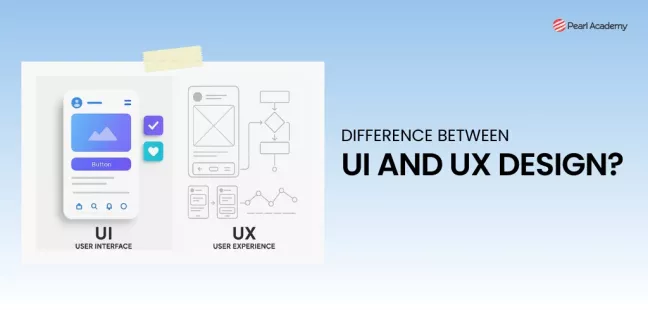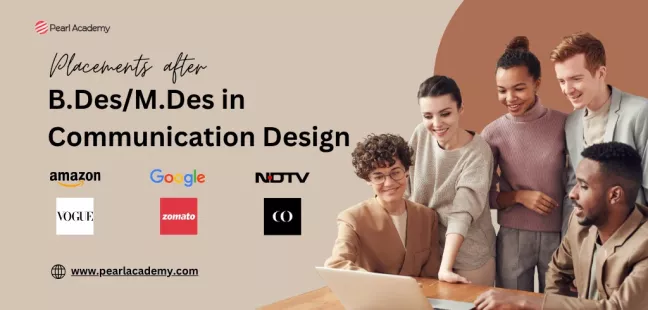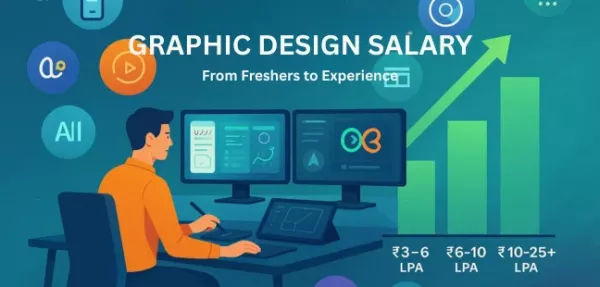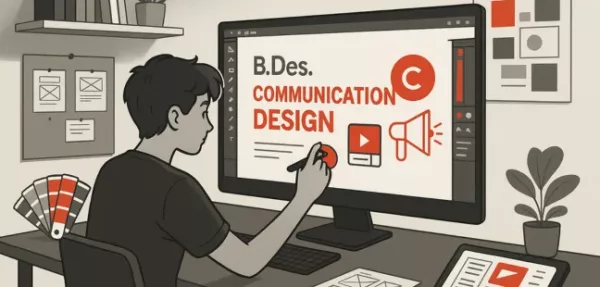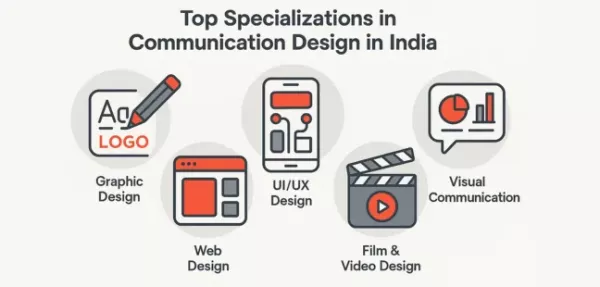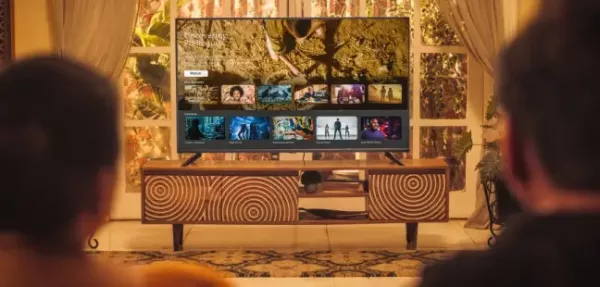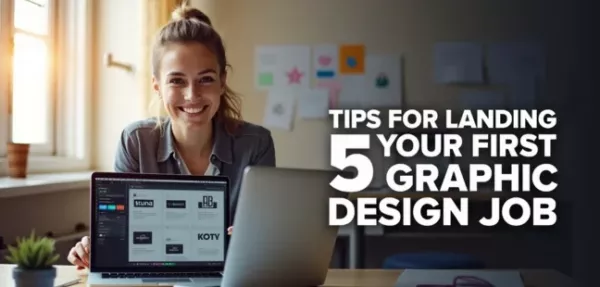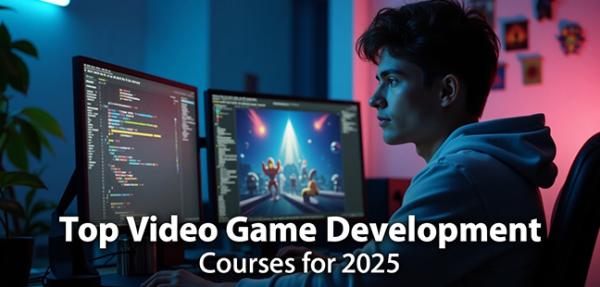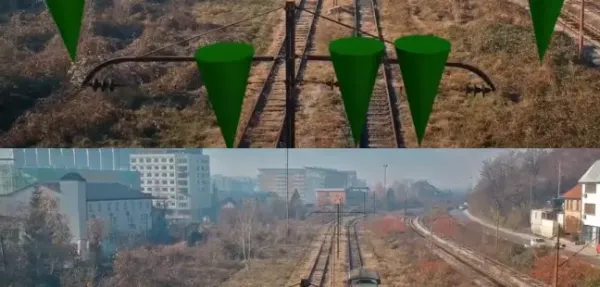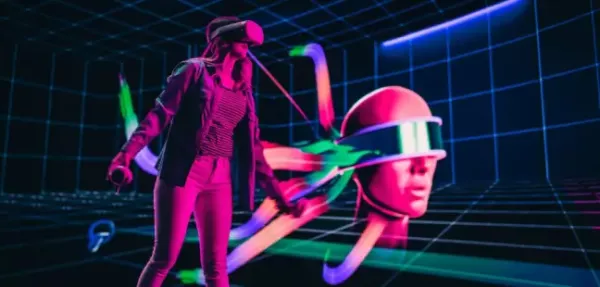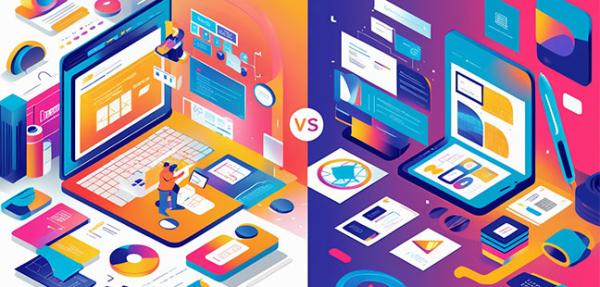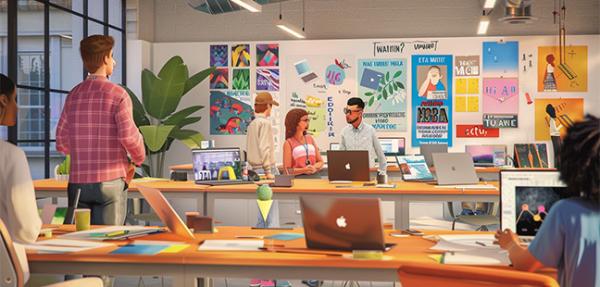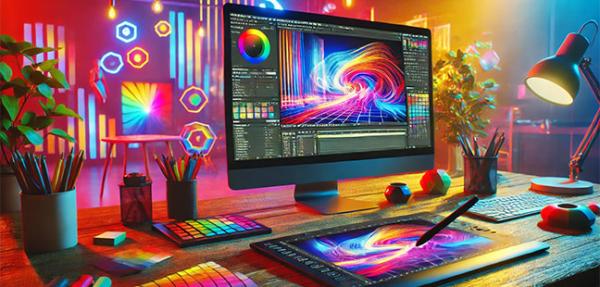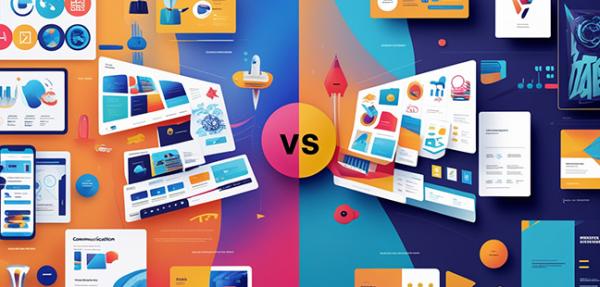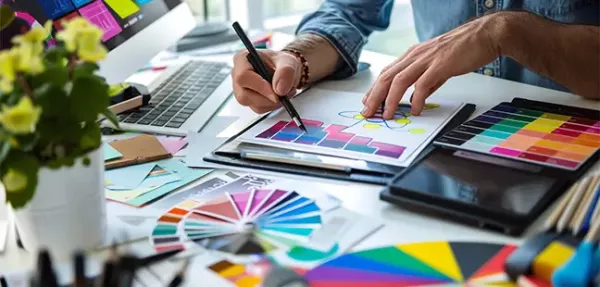Graphic Design Interview Questions and Answers
- Editorial Team
- Published 20-Jun-2025

- 5 General Graphic Design Interview Questions
- Technical Graphic Design Interview Questions
- 5 Work Ethics & Achievements Graphic Design Interview Questions
- 5 Skill-Based Graphic Design Interview Questions
- 5 Tips to Ace Your Graphic Design Interview
- Major Graphic Designer Hiring Industries: Skills & Application Guide
- Pearl Academy and Career in Graphic Design
- Conclusion
Graphic design interviews can get technical anytime very soon. After all, every graphic designer weaves magic with the help of various tools at their disposal. It is but natural that the interviewer would ask you questions that go beyond general themes, topics, and more. Get a comprehensive overview of the type of graphic design interview questions that can be asked, and their best answers to successfully land as a graphic designer in the company of your dreams. Keep on reading to gain useful knowledge and insights before you step into an interview room.
Become future-ready with our Communication Design Programs
Know More5 General Graphic Design Interview Questions
When stepping into the interview room, be ready to be interrogated about personality, self, and more.
S.No. | Interview Question | Why It’s Asked | What They Assess | How to Answer | Sample Answer |
1 | Tell us about yourself. | To evaluate your communication skills and understand your background and journey in design. | Your ability to summarize your profile confidently and align it with the role you're applying for. | Share a brief overview of your education, any relevant internships or projects, and your passion for design. | "I’m a recent graduate in Visual Communication from XYZ University. I’ve interned with a branding agency where I designed social media creatives and print ads. My strengths lie in conceptual thinking and clean design execution. I’m now eager to grow in a creative role that challenges me to solve real-world visual problems." |
2 | Why did you choose graphic design as a profession? | To understand your passion, motivation, and long-term commitment to the field. | Whether your interest in design is genuine and if you’ve thought deeply about your career choice. | Mention your early experiences, exposure to art/design, or a moment that inspired you to pursue it as a career. | "I’ve always been fascinated by how visuals can influence people’s perceptions. In high school, I started creating event posters and realized how much I enjoyed the process. Graphic design felt like the perfect blend of creativity and strategy, and that’s what drew me into this profession." |
3 | How would you define graphic design? | To test your fundamental understanding of what graphic design is and how you perceive its role. | Your ability to articulate core design concepts and show conceptual clarity. | Provide a concise and clear definition, emphasizing design as a problem-solving and communication tool. | "Graphic design is visual communication—it’s about using elements like typography, color, layout, and imagery to convey messages and solve problems creatively. It’s where function meets aesthetics to inform, engage, or persuade an audience." |
4 | What do you think makes someone a good designer? | To understand the values and qualities you associate with successful designers. | Your understanding of soft skills, work ethic, and the mindset required in design. | Talk about traits like creativity, adaptability, empathy, and attention to detail. | "A good designer listens deeply, communicates clearly, and is open to feedback. Beyond creativity, they need empathy to understand the user and adaptability to handle different projects or client needs. Continuous learning is also key." |
5 | Why are you interested in working for our company? | To see if you’ve researched the company and whether your goals align with its culture and mission. | Your seriousness about the role and whether you’re a cultural fit. | Mention specific things about the company—its design style, clients, values, or recent projects—that resonate with you. | "I really admire your brand’s approach to clean, functional design. I’ve followed your campaigns for [product/brand], and I’m impressed by the consistency and creativity in your messaging. I’d love to contribute to such impactful work while growing under a team known for excellence." |
Technical Graphic Design Interview Questions
As a graphic designer you are expected to know many technical tools that produce best images, infographics, banners, and more. Be sure you’d be questioned on the usage of tools, and other technical queries in the interview room:
S.No. | Interview Question | Why It’s Asked | What They Assess | How to Answer | Sample Answer |
1 | What design software are you proficient in? | To assess whether you have the technical proficiency required for the job. | Your familiarity with industry-standard tools and your ability to apply them in real-world projects. | List specific tools (e.g., Adobe Creative Suite, Figma, Canva), along with examples of how you’ve used them. | "I’m proficient in Adobe Illustrator, Photoshop, and InDesign. I use Illustrator mainly for vector work like logo design, Photoshop for image editing, and InDesign for layouts like brochures. I also use Figma for interface mockups and collaborative design." |
2 | Can you walk us through your design process? | To understand how you approach projects from start to finish. | Your organization, creative thinking, and ability to execute a design brief. | Break your process into phases—research, ideation, creation, feedback, and delivery. | "I begin by understanding the brief and target audience. Then I research references and sketch initial concepts. I choose the strongest idea, build a digital draft, and share it for feedback. After revisions, I finalize the design and deliver it in appropriate formats." |
3 | How do you handle tight deadlines? | To assess your time management and stress-handling skills. | Your ability to deliver quality work within constraints. | Mention tools, planning methods, or prioritization strategies you use to meet deadlines. | "I create a task timeline, divide the project into phases, and focus on essential elements first. I use tools like Trello or Google Calendar to stay organized. If I anticipate a delay, I inform stakeholders early to reset expectations." |
4 | Describe a challenging design project and how you handled it. | To test your resilience and problem-solving capabilities in difficult situations. | How you react under pressure and your ability to manage client feedback or design limitations. | Choose a specific project, outline the challenge, and explain how you resolved it. | "A client kept requesting changes after finalizing the design. I introduced a revision limit and set clearer expectations. We also held a mid-point check-in, which improved communication and helped us finalize faster." |
5 | How do you ensure your designs are user-friendly? | To see if you think beyond aesthetics and consider user experience. | Your understanding of usability, accessibility, and intuitive design. | Talk about layout hierarchy, font readability, color contrast, and user testing. | "I keep navigation simple, ensure text readability, and use clear visual hierarchy. For digital designs, I test them on multiple devices and gather feedback before finalizing." |
6 | What is your experience with responsive design? | To assess your readiness for designing across devices. | Whether you understand fluid layouts, media queries, or design tools for responsiveness. | Mention tools and techniques you’ve used to adapt designs for multiple screen sizes. | "I’ve worked on landing pages using Figma and Adobe XD with auto-layouts and responsive breakpoints. I understand how to create adaptable grid systems and ensure consistency across devices." |
7 | How do you stay updated with design trends? | To check your curiosity and dedication to ongoing learning. | Your engagement with the design community and awareness of modern practices. | Mention design blogs, social platforms, events, or online courses you follow. | "I follow Behance, Awwwards, and Dribbble for inspiration. I also take Skillshare and LinkedIn Learning courses, and subscribe to design newsletters like Creative Bloq and Smashing Magazine." |
8 | Can you explain the difference between vector and raster graphics? | To test your technical fundamentals. | Your understanding of file formats, resolution, and image types. | Define both types and give examples of their ideal uses. | "Vector graphics are made of paths and are resolution-independent—ideal for logos and illustrations. Raster graphics are pixel-based and best for detailed images like photos. I use Illustrator for vector work and Photoshop for raster editing." |
5 Work Ethics & Achievements Graphic Design Interview Questions
Working in an office environment, along with people requires one to have many inter-personal skills, which help you navigate turbulent waters sometimes. The interview board knows that and will be testing you on how beautifully you handle chaos:
S.No. | Interview Question | Why It’s Asked | What They Assess | How to Answer | Sample Answer |
1 | How do you handle constructive criticism? | To understand how you respond to feedback, especially in collaborative or client-facing roles. | Your professionalism, openness to improvement, and ability to work in a team. | Express that you value feedback and use it to improve your designs rather than taking it personally. | "I see feedback as a key part of the creative process. I listen actively, ask clarifying questions, and apply suggestions that align with the design goals. It helps me learn and create better outcomes for the client or audience." |
2 | Describe a time you went above and beyond for a project. | To evaluate your work ethic and willingness to take initiative beyond what's expected. | Your commitment to quality, problem-solving mindset, and sense of ownership. | Share a story where you exceeded expectations—either through extra effort, innovation, or initiative. | "For a college fest branding project, I was only supposed to design the poster. But I went on to create teaser videos, Instagram templates, and venue signage. The organizers said the cohesive branding made a huge difference in visibility and turnout." |
3 | How do you prioritize multiple projects? | To assess your time management and organizational skills. | Your ability to meet deadlines, manage resources, and deliver consistent quality. | Mention how you rank tasks based on urgency, impact, and deadlines, and how you track progress. | "I maintain a task board on Trello and sort projects based on urgency and complexity. I break each project into milestones, block calendar time, and communicate early if deadlines need adjustment. This helps me stay on top of work without burning out." |
4 | What do you consider your greatest professional achievement? | To gauge your personal standards, confidence, and contributions to previous projects. | The impact of your work and how you evaluate your own success. | Highlight a specific project, the challenge, your role, and the result (ideally quantifiable). | "I led a rebranding project for a small NGO. I created a new logo, social media kit, and website design. After the relaunch, their social engagement grew 3x and they received increased funding and volunteer support. Seeing my work drive real impact was very fulfilling." |
5 | How do you handle repetitive tasks without losing creativity? | To check your ability to stay consistent and motivated while working on similar deliverables. | Your mindset, discipline, and ability to deliver high-quality work over time. | Explain how you balance repetition with small creative changes or streamline work using templates. | "I use design systems and templates for consistency but add small creative twists to keep things fresh. I also break the monotony by alternating between creative and operational tasks throughout the day." |
5 Skill-Based Graphic Design Interview Questions
Any company would like to hire the most skilled graphic designer. Make sure to highlight your skills effectively in your resume and be able to discuss them with confidence and flair. Some skill-based questions that can be asked are listed below:
S.No. | Interview Question | Why It’s Asked | What They Assess | How to Answer | Sample Answer |
1 | How proficient are you with Adobe Creative Suite? | To assess your hands-on capability with essential graphic design software tools. | Your software fluency and ability to complete tasks efficiently using industry-standard programs. | Mention specific tools (e.g., Illustrator, Photoshop, InDesign), the level of expertise you have, and the types of projects you’ve used them for. | "I’m very comfortable with Adobe Illustrator for vector graphics, Photoshop for image editing, and InDesign for print layouts. I’ve used these tools for logo design, social media content, and brochures. For instance, I recently designed a tri-fold brochure in InDesign that was printed for a school event." |
2 | Do you have experience with motion graphics or animation? | To understand the breadth of your design skills and whether you can handle multimedia tasks. | Your versatility and comfort with visual storytelling beyond static designs. | Talk about your experience with motion tools like After Effects, Premiere Pro, Canva, or any platform where you’ve animated content. | "Yes, I’ve created basic animations and motion graphics using Adobe After Effects and Canva Pro. I designed animated Instagram reels for a local boutique and created a kinetic typography video as a college project." |
3 | How do you approach designing for accessibility? | To assess whether your designs are inclusive and user-friendly for diverse audiences. | Your sensitivity to readability, contrast, and usability considerations in design. | Mention accessibility principles like high color contrast, legible fonts, alt text, and responsive layouts. | "I follow accessibility guidelines such as maintaining color contrast ratios, using scalable fonts, and ensuring simple layouts. I also include alt text in digital designs and make sure text isn't embedded in images to support screen readers." |
4 | Can you describe your experience with branding projects? | To evaluate how well you understand the strategic and visual elements of brand identity design. | Your ability to create cohesive visual systems across different media. | Share a project where you developed brand assets like logos, color schemes, and typography. | "I worked on branding for a home-baking business where I created a logo, packaging design, and social media templates. I ensured consistency in color palette, tone, and typefaces across all brand touchpoints." |
5 | How do you ensure consistency across different design platforms? | To assess your attention to detail and how you maintain brand integrity. | Your ability to manage cross-platform designs for print, web, and mobile. | Talk about using brand guidelines, design systems, and thorough reviews across devices or formats. | "I create a style guide with brand colors, typography, image rules, and layout standards. I use shared libraries in Adobe CC and Figma to maintain uniformity, and I always test designs on multiple screen sizes before final approval." |
5 Tips to Ace Your Graphic Design Interview
A little help with tips, tricks, and strategies go a long way in helping to nail a graphic design interview. Some of them are listed below for your benefit. Read them:
S.No. | Tip | Why It’s Important | How to Apply It | Pro Tip |
1 | Curate a Tailored Portfolio | Your portfolio is your strongest advocate in a design interview. | Include 5–7 projects that reflect your versatility—logos, branding, UI/UX, and motion graphics. Customize it based on the company’s style. | Present your design thinking process, not just final outcomes. Include briefs, ideation sketches, and before-after comparisons. |
2 | Research the Company’s Visual Language | Employers want candidates who “get” their aesthetic. | Study the brand’s past campaigns, typography style, and color palette. Show you understand their tone—be it minimalistic, playful, or corporate. | Suggest one small way to elevate a recent design during your interview. |
3 | Prepare for a Live Test or Task | Many companies assess practical skills through timed tests. | Brush up on design tools like Adobe Illustrator, Photoshop, and Figma. Practice mock assignments like redesigning a landing page or logo under 1 hour. | Focus on clarity and creativity. Don't panic—structure your work and annotate if needed. |
4 | Master the ‘Why’ Behind Your Designs | Hiring managers care about your rationale, not just visuals. | Be ready to explain your color choices, font pairings, and layout logic. Link every design element to the brief’s goals. | Frame your work using impact statements like “This increased click-through by 30%” or “It simplified user navigation.” |
5 | Practice Your Verbal and Visual Storytelling | Communication is as crucial as design skills in collaborative roles. | Prepare clear answers for common graphic designer interview questions. Rehearse a 2-minute self-introduction that blends your passion, experience, and goals. | Record yourself and review posture, tone, and clarity. Keep it conversational and confident. |
Major Graphic Designer Hiring Industries: Skills & Application Guide
Whether you're interested in branding, UI/UX, or motion graphics, aligning your portfolio with industry-specific expectations is key to landing the job. Below is a comprehensive guide to the top hiring industries, essential skills they seek, and how you can apply.
Industry | Top Skills Required | How to Apply |
| Advertising & Branding | Adobe Creative Suite, Typography, Logo Design, Visual Storytelling | Apply via agency websites (e.g., Ogilvy, Dentsu), Behance portfolio, LinkedIn |
| Media & Publishing | Layout Design, InDesign, Editorial Design, Print Production | Apply via publishing houses or platforms like TimesJobs, LinkedIn |
| IT & Software (UI/UX) | Figma, Adobe XD, Wireframing, Prototyping, UX Research | Apply on tech job portals (e.g., AngelList, Internshala), company careers pages |
| Fashion & Lifestyle | Lookbooks, Social Media Design, Packaging, Brand Identity | Direct applications on brand sites (e.g., Nykaa, H&M), or LinkedIn listings |
| E-Commerce & Retail | Product Mock-ups, Catalogue Design, Emailers, Landing Pages | Use portals like Naukri, LinkedIn, or design hiring platforms like Dribbble Jobs |
| Gaming & Animation | Concept Art, Motion Graphics, 2D/3D Animation, Unity/Unreal Engine | Apply via gaming studios (e.g., Ubisoft, Pearl EDGE partners), ArtStation |
| EdTech & E-Learning | Infographics, Explainer Videos, LMS UI, Illustration | Use job portals (e.g., Foundit, LinkedIn), pitch via portfolio sites |
| Digital Marketing Agencies | Social Media Creatives, Brand Kits, Carousel Ads, GIFs, SEO Visuals | Submit portfolios to agencies or on Upwork, Fiverr, Freelancer |
| Startups | End-to-End Branding, Pitch Decks, Motion Graphics, Canva & Figma | Look on AngelList, LinkedIn Startups page, startup Slack/Discord groups |
| Corporate/Finance | Presentation Design, Internal Branding, Report Layouts, Minimal Design Aesthetic | Apply through company careers page or LinkedIn Jobs |
Whether you're a fresher or a seasoned designer, clarity on what each sector wants will give your career the creative edge it deserves.
Pearl Academy and Career in Graphic Design
If you're a design enthusiast looking to build a strong foundation and future-ready skills, Pearl Academy offers some of India’s most respected programs in creative education. Their Certificate Course in Game Design and Virtual Production is designed for budding visual and graphic designers who want to explore 2D/3D animation, AR/VR, and digital storytelling.
Graduates from Pearl go on to work at agencies like Wieden+Kennedy, Ogilvy, DDB Mudra, Netflix, and TCS. The hands-on learning, exposure to real-world projects, and global collaborations make Pearl a perfect launchpad for careers in:
- Graphic Design
- UI/UX
- Motion Graphics
- Visual Communication
- Digital Branding
- Gaming & Virtual Production
Whether you're applying for your first internship or aiming to lead a design team, Pearl’s curriculum helps you build portfolios that employers can’t ignore.

Student Guidance Center: Our Counselors are Just a Click Away.
Conclusion
Preparing for a graphic design interview is about more than knowing software—it’s about communicating your creative process, solving problems visually, and aligning with the company’s brand ethos. With the sample graphic design interview questions and answers above, along with insights into what hiring managers want, you’re already ahead of the competition.
More Interview Prep Guides You’ll Find Helpful
Tags
- #Communication Design
Pearl Admission Enquiry
Subscribe to Pearl Blogs
By clicking the "Subscribe" button, I agree and accept the privacy policy of Pearl Academy.










